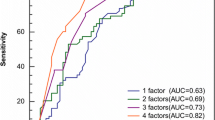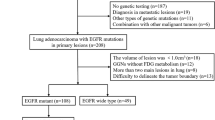Abstract
Objective Epidermal growth factor receptor (EGFR) mutations in lung adenocarcinoma are involved in the tumorigenesis and regulation of cell metabolism via Akt signaling. F-18 fluorodeoxyglucose-positron emission tomography ([18F]FDG PET), a functional imaging modality, can be used to measure tumor cell metabolism. Thus, in this study, we hypothesize that there exist correlations between EGFR mutation status and [18F]FDG uptake of advanced lung adenocarcinoma. Methods From May 2004 to April 2008, patients with stage IIIB or IV lung adenocarcinoma who underwent [18F]FDG PET and EGFR mutation analysis before receiving any treatment were eligible to participate in this study. The association of EGFR mutation status with patient characteristics and the SUVMAX from the [18F]FDG PET was evaluated. Multivariate logistic regression analysis was used to analyze predictors of EGFR mutations. Results Seventy-seven lung adenocarcinoma patients were included in this study. EGFR mutations were identified in 49 (64%) of the patients. The [18F]FDG uptake was significantly higher in EGFR-mutant (mean SUVMAX = 10.5 ± 4.7) than wild-type (8.0 ± 3.3) lung adenocarcinoma patients (P = 0.008). The median SUVMAX was 9.5, and patients with an SUVMAX ≥ 9.5 were more likely to harbor EGFR mutations (P = 0.009). In the multivariate analysis, an SUVMAX ≥ 9.5 remained a statistically significant predictor of EGFR mutations (P = 0.005). Conclusions Among Asian patients with advanced lung adenocarcinoma, those with higher SUVMAX on the [18F]FDG PET are more likely to carry EGFR mutations.

Similar content being viewed by others
References
Health Statistics in Taiwan, 2007. Department of Health, Executive Yuan, Taiwan, ROC.
Minna JD, Roth JA, Gazdar AF. Focus on lung cancer. Cancer Cell. 2002;1:49–52. doi:10.1016/S1535-6108(02)00027-2.
Chen KY, Chang CH, Yu CJ, Kuo SH, Yang PC. Distribution according to histologic type and outcome by gender and age group in Taiwanese patients with lung carcinoma. Cancer. 2005;103:2566–74. doi:10.1002/cncr.21087.
Jorissen RN, et al. Epidermal growth factor receptor: mechanisms of activation and signalling. Exp Cell Res. 2003;284:31–53. doi:10.1016/S0014-4827(02)00098-8.
Yarden Y, Sliwkowski MX. Untangling the ErbB signalling network. Nat Rev Mol Cell Biol. 2001;2:127–37. doi:10.1038/35052073.
Sordella R, Bell DW, Haber DA, Settleman J. Gefitinib-sensitizing EGFR mutations in lung cancer activate anti-apoptotic pathways. Science. 2004;305:1163–7. doi:10.1126/science.1101637.
Datta SR, Brunet A, Greenberg ME. Cellular survival: a play in three Akts. Genes Dev. 1999;13:2905–27. doi:10.1101/gad.13.22.2905.
Kohn AD, Summers SA, Birnbaum MJ, Roth RA. Expression of a constitutively active Akt Ser/Thr kinase in 3T3-L1 adipocytes stimulates glucose uptake and glucose transporter 4 translocation. J Biol Chem. 1996;271:31372–8. doi:10.1074/jbc.271.49.31372.
Hajduch E, Litherland GJ, Hundal HS. Protein kinase B (PKB/Akt)—a key regulator of glucose transport? FEBS Lett. 2001;492:199–203. doi:10.1016/S0014-5793(01)02242-6.
Mac Manus MP, et al. Positron emission tomography is superior to computed tomography scanning for response-assessment after radical radiotherapy or chemoradiotherapy in patients with non-small-cell lung cancer. J Clin Oncol. 2003;21:1285–92. doi:10.1200/JCO.2003.07.054.
Ryu JS, Choi NC, Fischman AJ, Lynch TJ, Mathisen DJ. FDG-PET in staging and restaging non-small cell lung cancer after neoadjuvant chemoradiotherapy: correlation with histopathology. Lung Cancer. 2002;35:179–87. doi:10.1016/S0169-5002(01)00332-4.
Vanuytsel LJ, et al. The impact of (18)F-fluoro-2-deoxy-D-glucose positron emission tomography (FDG-PET) lymph node staging on the radiation treatment volumes in patients with non-small cell lung cancer. Radiother Oncol. 2000;55:317–24. doi:10.1016/S0167-8140(00)00138-9.
Vesselle H, et al. Lung cancer proliferation correlates with [F-18]fluorodeoxyglucose uptake by positron emission tomography. Clin Cancer Res. 2000;6:3837–44.
Downey RJ, et al. Preoperative F-18 fluorodeoxyglucose-positron emission tomography maximal standardized uptake value predicts survival after lung cancer resection. J Clin Oncol. 2004;22:3255–60. doi:10.1200/JCO.2004.11.109.
Downey RJ, Akhurst T, Gonen M, Park B, Rusch V. Fluorine-18 fluorodeoxyglucose positron emission tomographic maximal standardized uptake value predicts survival independent of clinical but not pathologic TNM staging of resected non-small cell lung cancer. J Thorac Cardiovasc Surg. 2007;133:1419–27. doi:10.1016/j.jtcvs.2007.01.041.
Cerfolio RJ, Bryant AS, Ohja B, Bartolucci AA. The maximum standardized uptake values on positron emission tomography of a non-small cell lung cancer predict stage, recurrence, and survival. J Thorac Cardiovasc Surg. 2005;130:151–9. doi:10.1016/j.jtcvs.2004.11.007.
Kurata T, Oguri T, Isobe T, Ishioka S, Yamakido M. Differential expression of facilitative glucose transporter (GLUT) genes in primary lung cancers and their liver metastases. Jpn J Cancer Res. 1999;90:1238–43.
Higashi K, et al. Correlation of Glut-1 glucose transporter expression with. Eur J Nucl Med. 2000;27:1778–85. doi:10.1007/s002590000367.
Mamede M, et al. [18F]FDG uptake and PCNA, Glut-1, and Hexokinase-II expressions in cancers and inflammatory lesions of the lung. Neoplasia. 2005;7:369–79. doi:10.1593/neo.04577.
Shih JY, et al. Epidermal growth factor receptor mutations in needle biopsy/aspiration samples predict response to gefitinib therapy and survival of patients with advanced nonsmall cell lung cancer. Int J Cancer. 2006;118:963–9. doi:10.1002/ijc.21458.
Kelly K, Huang C. Biological agents in non-small cell lung cancer: a review of recent advances and clinical results with a focus on epidermal growth factor receptor and vascular endothelial growth factor. J Thorac Oncol. 2008;3:664–73. doi:10.1097/JTO.0b013e3181758141.
Perez-Soler R, et al. Determinants of tumor response and survival with erlotinib in patients with non-small-cell lung cancer. J Clin Oncol. 2004;22:3238–47. doi:10.1200/JCO.2004.11.057.
Kris MG, et al. Efficacy of gefitinib, an inhibitor of the epidermal growth factor receptor tyrosine kinase, in symptomatic patients with non-small cell lung cancer: a randomized trial. JAMA. 2003;290:2149–58. doi:10.1001/jama.290.16.2149.
Massarelli E, et al. A retrospective analysis of the outcome of patients who have received two prior chemotherapy regimens including platinum and docetaxel for recurrent non-small-cell lung cancer. Lung Cancer. 2003;39:55–61. doi:10.1016/S0169-5002(02)00308-2.
Inoue A, et al. Prospective phase II study of gefitinib for chemotherapy-naive patients with advanced non-small-cell lung cancer with epidermal growth factor receptor gene mutations. J Clin Oncol. 2006;24:3340–6. doi:10.1200/JCO.2005.05.4692.
Asahina H, et al. A phase II trial of gefitinib as first-line therapy for advanced non-small cell lung cancer with epidermal growth factor receptor mutations. Br J Cancer. 2006;95:998–1004. doi:10.1038/sj.bjc.6603393.
Pao W, et al. EGF receptor gene mutations are common in lung cancers from “never smokers” and are associated with sensitivity of tumors to gefitinib and erlotinib. Proc Natl Acad Sci USA. 2004;101:13306–11. doi:10.1073/pnas.0405220101.
Paez JG, et al. EGFR mutations in lung cancer: correlation with clinical response to gefitinib therapy. Science. 2004;304:1497–500. doi:10.1126/science.1099314.
Lynch TJ, et al. Activating mutations in the epidermal growth factor receptor underlying responsiveness of non-small-cell lung cancer to gefitinib. N Engl J Med. 2004;350:2129–39. doi:10.1056/NEJMoa040938.
Yang CH, et al. Specific EGFR mutations predict treatment outcome of stage IIIB/IV patients with chemotherapy-naive non-small-cell lung cancer receiving first-line gefitinib monotherapy. J Clin Oncol. 2008;26:2745–53. doi:10.1200/JCO.2007.15.6695.
Marchetti A, et al. EGFR mutations in non-small-cell lung cancer: analysis of a large series of cases and development of a rapid and sensitive method for diagnostic screening with potential implications on pharmacologic treatment. J Clin Oncol. 2005;23:857–65. doi:10.1200/JCO.2005.08.043.
Cappuzzo F, et al. Epidermal growth factor receptor gene and protein and gefitinib sensitivity in non-small-cell lung cancer. J Natl Cancer Inst. 2005;97:643–55.
Fischer BM, Mortensen J, Hojgaard L. Positron emission tomography in the diagnosis and staging of lung cancer: a systematic, quantitative review. Lancet Oncol. 2001;2:659–66. doi:10.1016/S1470-2045(01)00555-1.
Sasaki R, et al. [18F]fluorodeoxyglucose uptake by positron emission tomography predicts outcome of non-small-cell lung cancer. J Clin Oncol. 2005;23:1136–43. doi:10.1200/JCO.2005.06.129.
Weber WA, et al. Positron emission tomography in non-small-cell lung cancer: prediction of response to chemotherapy by quantitative assessment of glucose use. J Clin Oncol. 2003;21:2651–7. doi:10.1200/JCO.2003.12.004.
Su H, et al. Monitoring tumor glucose utilization by positron emission tomography for the prediction of treatment response to epidermal growth factor receptor kinase inhibitors. Clin Cancer Res. 2006;12:5659–67. doi:10.1158/1078-0432.CCR-06-0368.
Blume-Jensen P, Hunter T. Oncogenic kinase signalling. Nature. 2001;411:355–65. doi:10.1038/35077225.
Cappuzzo F, et al. Akt phosphorylation and gefitinib efficacy in patients with advanced non-small-cell lung cancer. J Natl Cancer Inst. 2004;96:1133–41.
Acknowledgment
This study was supported by the Department of Medical Research of the National Taiwan University Hospital and by grant (NSC-95-2314-B-002-110-MY3 for J.-Y. Shih) from the National Science Council, Taiwan.
Author information
Authors and Affiliations
Corresponding author
Rights and permissions
About this article
Cite this article
Huang, CT., Yen, RF., Cheng, MF. et al. Correlation of F-18 fluorodeoxyglucose-positron emission tomography maximal standardized uptake value and EGFR mutations in advanced lung adenocarcinoma. Med Oncol 27, 9–15 (2010). https://doi.org/10.1007/s12032-008-9160-1
Received:
Accepted:
Published:
Issue Date:
DOI: https://doi.org/10.1007/s12032-008-9160-1




